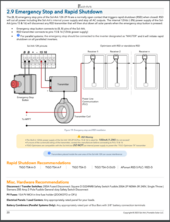physicsguy
New Member
I am thinking of installing a critical loads subpanel and some battery storage and later maybe some solar to directly charge the batteries. (I already have a grid-tie 3.5kw solar array with micro inverters). Meanwhile, I'll use wall grid AC in battery EPS mode to keep the batteries topped off. The battery (e.g., an EcoFlow Delta Pro) will automatically switch to battery upon grid failure. Here are my questions.
1. Even without new DC solar coupling to the battery, don't firefighters need to be protected from live AC from the battery inverter going thru the subpanel distribution? Do I have to have some kind of labeled shutoff button/switch near the outdoor main panel to disconnect the indoor subpanel's output from any circuits?
2. If I add DC coupled (to the battery only) solar later (roof top or ground mount) do I need some kind of module level rapid shutdown (which if triggered by grid shutdown would seem to defeat the purpose of the whole system) or would a manual DC shutoff switch in some conspicuous location suffice? (I assume I'd still need some kind of shutoff for the AC subpanel output if I needed it for question 1 above.) Thanks for any help.
1. Even without new DC solar coupling to the battery, don't firefighters need to be protected from live AC from the battery inverter going thru the subpanel distribution? Do I have to have some kind of labeled shutoff button/switch near the outdoor main panel to disconnect the indoor subpanel's output from any circuits?
2. If I add DC coupled (to the battery only) solar later (roof top or ground mount) do I need some kind of module level rapid shutdown (which if triggered by grid shutdown would seem to defeat the purpose of the whole system) or would a manual DC shutoff switch in some conspicuous location suffice? (I assume I'd still need some kind of shutoff for the AC subpanel output if I needed it for question 1 above.) Thanks for any help.




